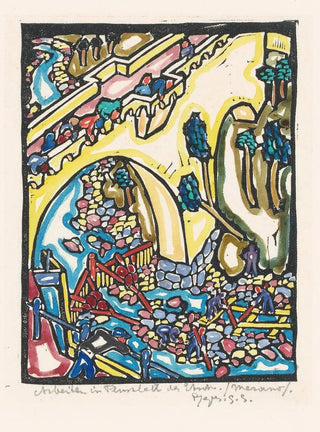Art print | Working in the Adige bed - Reijer Stolk


View from behind

Frame (optional)
In the fascinating world of art, some works stand out for their ability to evoke deep emotions and capture fleeting moments. "Working in the bed of the Adige - Reijer Stolk" is a striking example, offering a window into a landscape that is both natural and human. This piece invites the viewer to immerse themselves in a scene where nature and labor intersect, revealing a delicate balance between man and his environment. The soft light bathing the composition creates a peaceful, almost meditative atmosphere that encourages contemplation. Every detail, every nuance of color, contributes to the overall harmony, making this work a true ode to rural life.
Style and uniqueness of the work
Reijer Stolk's style is characterized by meticulous attention to detail and a subtly chosen color palette. In "Working in the bed of the Adige," the artist manages to capture the texture of natural elements, whether it is the water shimmering under the sun or the lush greenery framing the scene. The composition is carefully balanced, with each element placed with precision that reflects the artist's craftsmanship. The human figures, though modest in their depiction, are imbued with a certain dignity, illustrating the unbreakable bond between man and land. This poetic realism gives the piece a timeless dimension, allowing the viewer to feel a profound connection with the characters and their environment.
The artist and his influence
Reijer Stolk, an emblematic figure of Dutch art, knew how to leave his mark on his era with a distinctive style that combines tradition and innovation. His works, often inspired by nature and everyday life, demonstrate a particular sensitivity towards landscapes and genre scenes. Stolk was influenced by the old masters, while developing a personal approach that is uniquely his own. His work reflects an intimate understanding of the nuances of light and shadow, as well as a capacity to convey emotions through carefully orchestrated compositions. By exploring universal themes such as work, nature, and harmony, he

Matte finish

View from behind

Frame (optional)
In the fascinating world of art, some works stand out for their ability to evoke deep emotions and capture fleeting moments. "Working in the bed of the Adige - Reijer Stolk" is a striking example, offering a window into a landscape that is both natural and human. This piece invites the viewer to immerse themselves in a scene where nature and labor intersect, revealing a delicate balance between man and his environment. The soft light bathing the composition creates a peaceful, almost meditative atmosphere that encourages contemplation. Every detail, every nuance of color, contributes to the overall harmony, making this work a true ode to rural life.
Style and uniqueness of the work
Reijer Stolk's style is characterized by meticulous attention to detail and a subtly chosen color palette. In "Working in the bed of the Adige," the artist manages to capture the texture of natural elements, whether it is the water shimmering under the sun or the lush greenery framing the scene. The composition is carefully balanced, with each element placed with precision that reflects the artist's craftsmanship. The human figures, though modest in their depiction, are imbued with a certain dignity, illustrating the unbreakable bond between man and land. This poetic realism gives the piece a timeless dimension, allowing the viewer to feel a profound connection with the characters and their environment.
The artist and his influence
Reijer Stolk, an emblematic figure of Dutch art, knew how to leave his mark on his era with a distinctive style that combines tradition and innovation. His works, often inspired by nature and everyday life, demonstrate a particular sensitivity towards landscapes and genre scenes. Stolk was influenced by the old masters, while developing a personal approach that is uniquely his own. His work reflects an intimate understanding of the nuances of light and shadow, as well as a capacity to convey emotions through carefully orchestrated compositions. By exploring universal themes such as work, nature, and harmony, he






